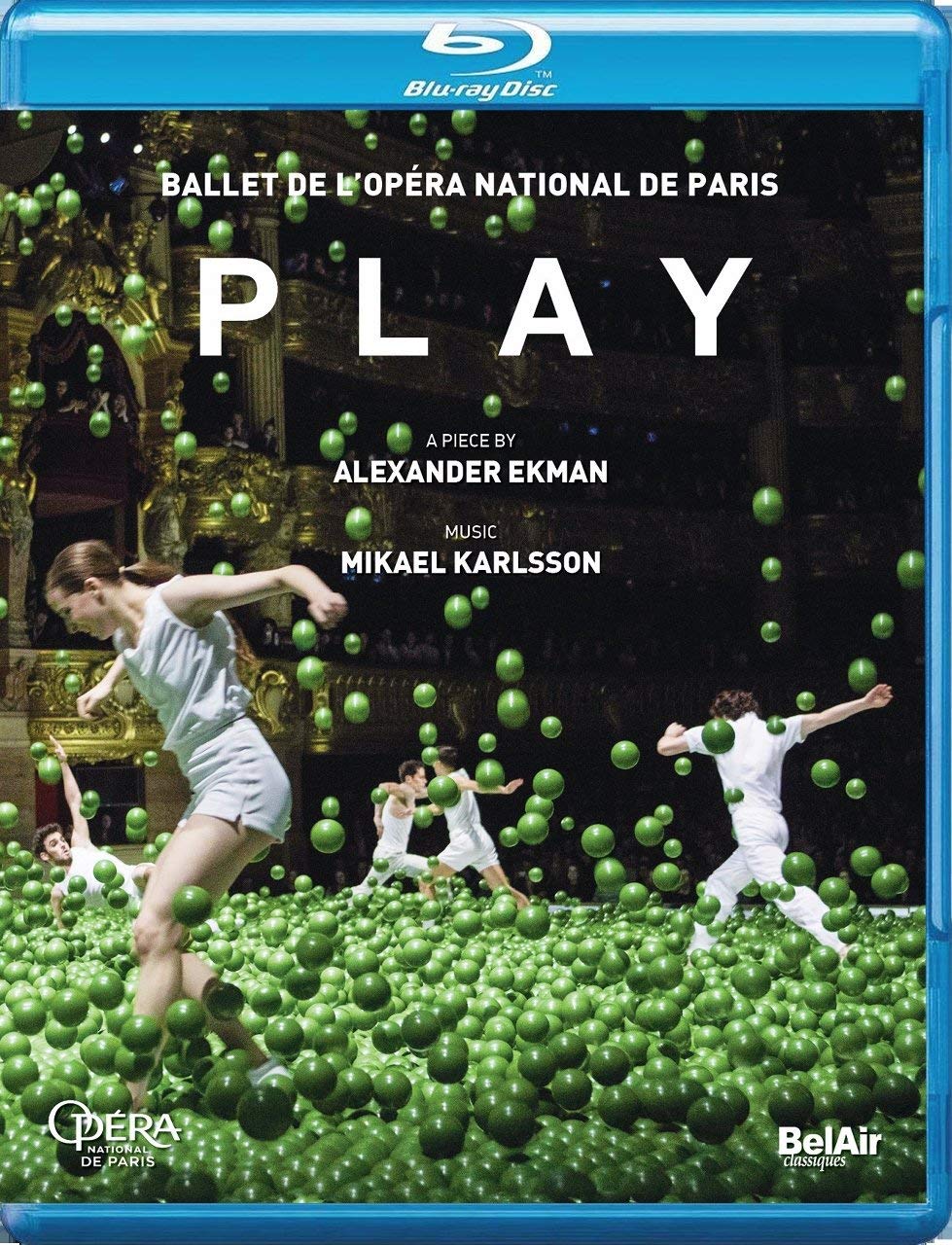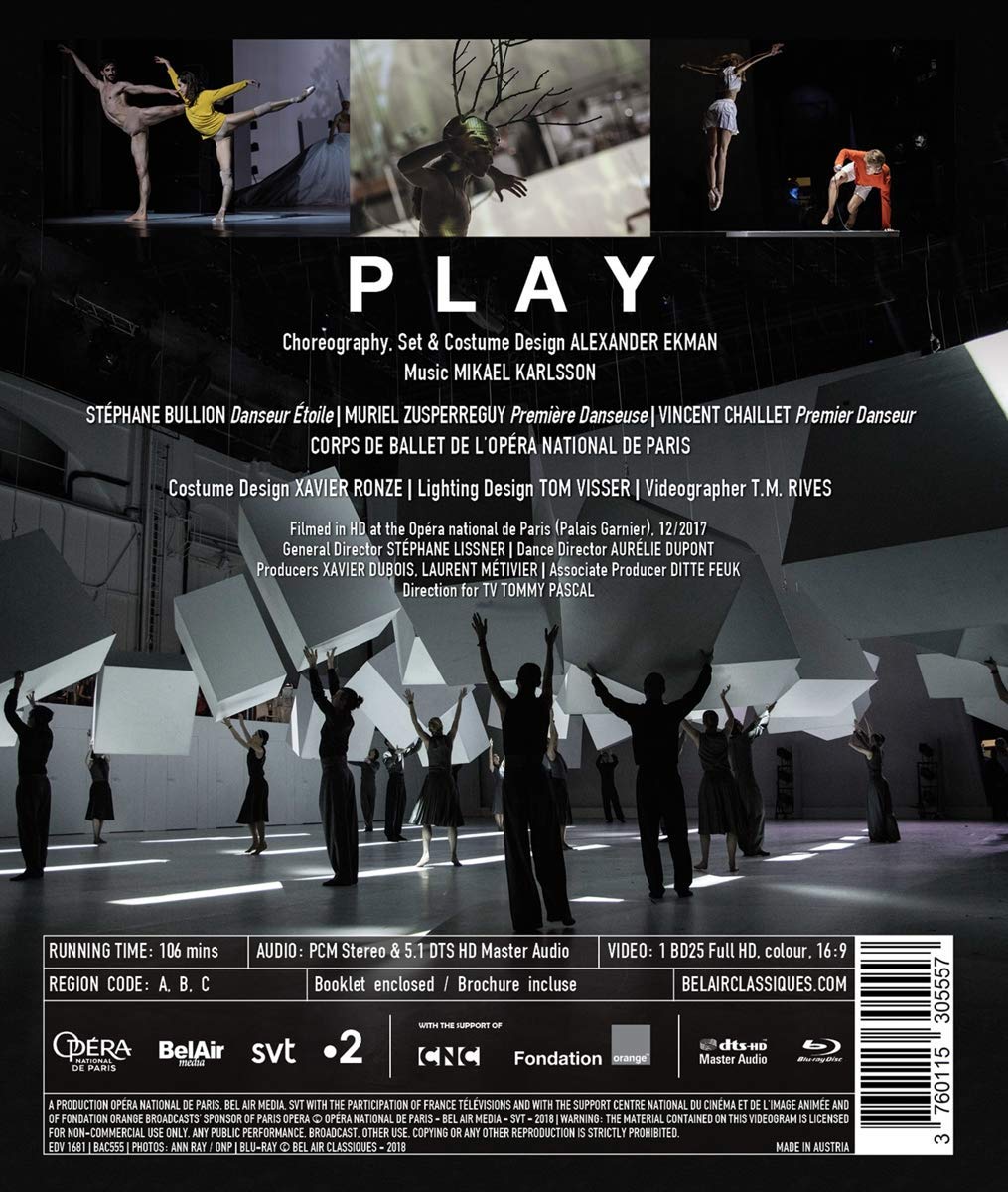

Play dance production recorded 2017 at the Opéra national de Paris (Palais Garnier). Choreographed by Alexander Ekman and assistant Ana Maria Lucaciu. Music by Mikael Karlsson. Stars Stéphane Bullion (Danseur Étoile), Muriel Zusperreguy (Première Danseuse), Vincent Chaillet (Premier Danseur), and the following dancers from the Corps de Ballet: Marion Barbeau, Aurélia Bellet, Alice Catonnet, Silvia Saint-Martin, Ida Vikinkoski, Juliette Hilaire, Laurène Levy, Charlotte Ranson, Jennifer Visocchi, Claire Gandolfi, Marion Gautier de Charnacé, Clémence Gross, Caroline Osmont, Sofia Rosolini, Chelsea Adomaitis, Margaux Gaudy-Talazac, Mouget Shanti, Aurélien Houette, Allister Madin, Marc Moreau, Jérémy-Loup Quer, Daniel Stokes, Simon Valastro, Adrien Couvez, Yvon Demol, Alexandre Gasse, Antoine Kirscher, Mickaël Lafon, Hugo Vigliotti, Takeru Coste, Simon Le Borgne, Antonin Monié, and Andréa Sarri. Musicians are: Calesta “Callie” Day (Singer), Frédéric Vaysse Knitter (Piano), Amanda Favier (First Violin), Pauline Fritsch (Second Violin), Benoît Marin (Viola), Éric Villeminey (Cello), François Gavelle (Double Bass), Christian Wirth (Soprano Saxophone), Géraud Etrillard (Alto Saxophone), Adrien Lajoumard (Tenor Saxophone), Pascal Bonnet (Baritone Saxophone), and Adélaïde Ferrière (Drums). There are two songs sung with lyrics, we think, from Mikael Karlsson. The voice of Alan Watts appears briefly with words from the Tao of Philosophy. (Sorry, no subtitles.) Set and costumes by Alexander Ekman; additional costume design by Xavier Ronze; lighting design by Tom Visser; videography by T.M. Rives. Directed for TV by Tommy Pascal. The aspect radio is 16:9. As in the case of previous Ekman recordings, the film is presented motion-picture style with horizontal black bars along the top and bottom of the screen giving the appearance of a wider aspect ratio. We cropped the black bars for the screenshots below. Released 2018, disc has 5.1 dts-HD Master Audio sound. Grade: A-
Below is the Palais Garnier and the Play audience. The Phantom now rarely attends performances as he is usually booked up with beautiful women lusting to ride in his boat. The Garnier isn’t quite as salacious as it was portrayed in the movie, but it is still the most outrageous opera house we have seen:
As you see in the next 2 screenshots below, the grand opulence of the Garnier stands in sharp contrast to the jaunty surrealism of Ekman’s conception and Mikael Karlsson’s terrifically engaging modern jazz music. The band itself is rather surreal with a saxophone quartet, a string quintet, a piano, a percussionist, and an American gospel singer! There’s no good view on the disc of all the musicians, but here’s the soprano, tenor, alto, and baritone sax group:
As explained above, our screenshots are in a motion-picture style aspect ratio. The next shot below is a beautiful close-up of Vincent Chaillet and Silvia Saint-Martin (seen stage center above) made by Ann Ray with high-resolution, still-image camera and featured in the keepcase booklet. Maybe one day we will be able to get incredibly fine images like this from our videos:
Act 1 is concerned with the “play of youth”, with everyone mostly dressed in light colors having fun in a series of scenes and stunts. Play is similar to Ekman’s earlier major works in that he creates a special stage environment and uses a lot of props (see A Swan Lake with it’s water stage and Midsummer Night’s Dream performed on a wheat field at harvest time). But Ekman also got many of his ideas from the dancers, who were encouraged to be creative during rehearsals :
The star of this show is really Simon Le Borgne, a Coryphée (2nd of 5 ranks), who dances the role of a kind of Everyman. Tall, rugged, and distinctive with his square jaw, he seems to be both an exhibitionist and a natural leader. In Act 1 he stands out in his orange top:
The tree-girl corps seen next below is maybe the closest thing to a Paris showgirl review that you’ll ever see in an opera house. There are only 3 senior dancers in this production. The remaining 33 are all beautiful and handsome beings from the corps, and they all seem really enthusiastic about the chance to show off :
Since Ekman uses small musical groups, he gets a chance to build a temporary stage over the orchestra pit. In the shot below the tree-girl in the foreground is on the stage over the pit. Later this part of the stage will be lowered:
Ekman comes up with many creative characters that are new (to us anyway) such as the dancing balloon shown next below. Has anyone else ever put this on a stage before?
Somewhere we read that the Paris Opera bought 40,000 green balls!
There isn’t a decent shot of all the musicians in Play. In our last shot from Act 1 below you can see the band on a stage high above at the rear. They use amplification throughout to tremendous effect. On your right you see the piano. Moving left the strings are lined up, then the saxophones, and finally a huge set of drums and keyboard instruments. Now the temporary stage has been lowered to be level with the laps of the front row of the audience. A lot of members of the audience left the house with props as souvenirs:
In Act 2, there is a deep change in tone as Ekman probes the absence of play in the lives of adults. All on board (including the musicians!) are clothed in gray or black. The dancers (all with streaks of gray hair) earnestly try to cope with the challenges of maturity. In the next 2 screenshots we see more of Le Borge as Everyman, who, thinking perhaps of Hamlet, performs a kind of “To play or not to play” solo:
The strange blue lips above are part of a simple device from Ekman that we haven’t seen before: a video projection on the front of the main theater curtain! You see this more clearly in the next shot below where an ominous visage (of Le Borghe again!) overlooks men dancing on the lowered pit stage:
And who are these men? Well, Stéphane Bullion (Danseur Étoile) leads the corps in somber formations from a chapter on the disc called “Men at work”:
The next two screenshots come from a scene called “The universe is basically playful.” But Ekman observes that adults tend to watch others at play. To illustrate this, Ekman gives us a beautiful classical pas de deux performed on a stage inside the stage (not sure, but we think the couple is Silvia Saint-Martin with escort Vincent Chaillet):
The classical pas de deux is soon followed by Bullion and Muriel Zusperreguy (Première Danseuse) performing a mechanistic, modern, adult pas de deux that is anything but playful :
Next below are two shots from what is called in the keepcase booklet a “A factory scene.”
And the show ends with Everyman stripping and exiting in defeat:
H’m. What’s this all about? Well, Ekman poses a dilemma. Being young is so wonderful because you get to play. But what happens to play when you are older? Sure, if you’re an artist (like an Étoile in the Paris Opera Ballet) you have a shot at making a living doing something you could consider “play.” Or maybe for play you can try to create a website on the weekend for others to enjoy. But what if you gig as a forensic accountant or a proctologist? Is there hope? Or has Everyman died?
Hold the phone! After the official end of Play there is a surprise epilogue. The curtain comes up again, but there will be no curtain calls quite yet. Calesta Day appears front and center and suggests a way out of Ekman’s dilemma with a song (by Mikael Karlsson we think) called “Play, Years and Years.” Our favorite stanza: “The time has come, nally/To find the word/The word will tell you, loudly/To leave the herd.”
And as Calesta belts out about leaving the herd, the cast goes crazy. And so do the ticket holders who get a chance to play with giant balloons, various props, some of the dancers, and each other:
Play doesn’t have a story line, but it’s not purely abstract. It’s a mosaic of inventive and interesting choreography celebrating the joys of play and warning of the risks of forgetting to enjoy life as we grow older. Ekman was lucky (and deserving) to get the chance to produce his Play with the incomparably skilled and beautiful dancers of the Paris Opera Ballet. You will probably find this work worth revisiting quite a few times as you ponder all of Ekman’s ideas.
TV Director Tommy Pascal provides extremely high PQ and excellent color balance. Pascal makes a lot of music videos it seems, so it’s no surprise that his film here looks a bit like a huge Vimeo clip. We had to run a Work Worksheet on this. Alas, the pace here is too fast at 7.8 seconds per clip. And only 53% of the clips show the whole bodies of the dancers. So the video content here falls significantly short of what we usually like to see from our elite dancing groups. For more on this see our discussion of ballet video content in our story on the best ballet videos and our discussion of the disease of DVDitis in fine-art videos.
But perhaps the best thing of all about this show is the original live music. The foundation of every great ballet is great music. Karlsson has done the music for all of Ekman’s major works, each time with different small groups. He was lucky (and deserving) to get the resources for engaging the amazing ensemble he imagined for this. The music is, as Karlsson claims, both raw and beautiful. It’s also original, intriguing, arresting—and so clearly recorded by the expert sound technicians available to the Paris Opera.
Now to a grade. We start with an A+. The excessively fast pace and overuse of near and close-up shots knocks the grade down to C. But the interesting choreography and expert Paris dancers move the grade up to a B-. And finally, Karlsson’s music gets us up to A-.
Below is a trailer from the Opéra national de Paris that shows a bit about the making of Play. Many of the ideas you see here were cut or changed as the piece took shape:
OR























